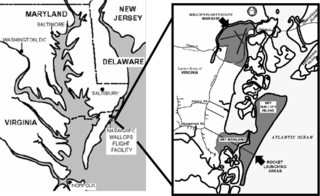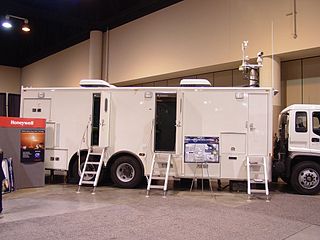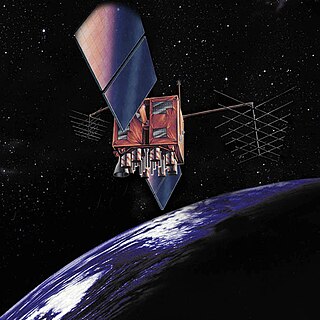Range Safety and Telemetry System (RSTS) is a GPS based, S-band telemetry receiving and UHF command destruct system, with two 5.4-meter telemetry and command destruct auto-tracking antennas. The system built by Honeywell International. The system is capable of providing four redundant telemetry links and expanding for added telemetry link receiving.
The prime purpose of the RSTS is to provide the range safety and telemetry functions necessary to track and verify a safe rocket flight within prescribed boundaries or safely terminate an errant rocket.
One of the, operationally identical, RSTS systems is located at the Kodiak Launch Center (KLC) in Alaska with the second mobile unit at varying mission specific sites, such as off-axis locations. Either system can act in conjunction with each other or as a stand-alone unit.
The RSTS is similar in design to the Ballistic Missile Range Safety Technology (BMRST) operated at Cape Canaveral Space Force Station, Florida.

Telemetry is the in situ collection of measurements or other data at remote points and their automatic transmission to receiving equipment (telecommunication) for monitoring. The word is derived from the Greek roots tele, 'remote', and metron, 'measure'. Systems that need external instructions and data to operate require the counterpart of telemetry: telecommand.

The Space Shuttle Solid Rocket Booster (SRB) was the first solid-propellant rocket to be used for primary propulsion on a vehicle used for human spaceflight. A pair of these provided 85% of the Space Shuttle's thrust at liftoff and for the first two minutes of ascent. After burnout, they were jettisoned and parachuted into the Atlantic Ocean where they were recovered, examined, refurbished, and reused.

Mercury-Atlas 3 (MA-3) was an unmanned spaceflight of the Mercury program. It was launched unmanned on April 25, 1961 at 16:15 UTC, from Launch Complex 14 at Cape Canaveral, Florida. The Mercury capsule contained a robotic "mechanical astronaut". Mercury spacecraft No. 8 and Atlas No. 8 100-D were used in the mission.

Mercury-Scout 1, or MS-1, was a United States spacecraft intended to test tracking stations for Project Mercury flights. It grew out of a May 5, 1961 NASA proposal to use Scout rockets to launch small satellites to evaluate the worldwide Mercury Tracking Network in preparation for crewed orbital missions. The launch of Mercury-Scout 1 on November 1, 1961, was unsuccessful, and the satellite failed to reach orbit.

Little Joe II was an American rocket used from 1963 to 1966 for five uncrewed tests of the Apollo spacecraft launch escape system (LES), and to verify the performance of the command module parachute recovery system in abort mode. It was named after a similar rocket designed for the same function in Project Mercury. Launched from White Sands Missile Range in New Mexico, it was the smallest of four launch rockets used in the Apollo program.

Wallops Flight Facility (WFF) is a rocket launch site on Wallops Island on the Eastern Shore of Virginia, United States, just east of the Delmarva Peninsula and approximately 100 miles (160 km) north-northeast of Norfolk. The facility is operated by the Goddard Space Flight Center in Greenbelt, Maryland, and primarily serves to support science and exploration missions for NASA and other Federal agencies. WFF includes an extensively instrumented range to support launches of more than a dozen types of sounding rockets; small expendable suborbital and orbital rockets; high-altitude balloon flights carrying scientific instruments for atmospheric and astronomical research; and, using its Research Airport, flight tests of aeronautical research aircraft, including unmanned aerial vehicles.

The Poker Flat Research Range (PFRR) is a launch facility and rocket range for sounding rockets in the U.S. state of Alaska, located on a 5,132-acre (20.77 km2) site at Chatanika, about 30 miles (50 km) northeast of Fairbanks and 1.5 degrees south of the Arctic Circle. More than 1,700 launches have been conducted at the range to study the Earth's atmosphere and the interaction between the atmosphere and the space environment. Areas studied at PFRR include the aurora, plasma physics, the ozone layer, solar proton events, Earth's magnetic field, and ultraviolet radiation. Rockets launched at PFRR have attained an apogee of 930 miles (1,500 km).

The Ronald Reagan Ballistic Missile Defense Test Site, commonly referred to as the Reagan Test Site, is a missile test range in Marshall Islands. It covers about 750,000 square miles (1,900,000 km2) and includes rocket launch sites at the Kwajalein Atoll, Wake Island, and Aur Atoll. It primarily functions as a test facility for U.S. missile defense and space research programs. The Reagan Test Site is under the command of the US Army Kwajalein Atoll, or USAKA.

Ballistic Missile Range Safety Technology (BMRST) is a mobile system designed and built by Honeywell International in Clearwater Florida, to monitor and provide space-vehicle position data during launches. The BMRST system consists of a control center van and two trailer-mounted tracking antennas. All data processing and range safety displays are housed in the control center; the antennas are designed to receive data from launched rockets and space vehicles and transmit the information back to the control center. From the control center, the Range Safety Officer will also be able to assist in destroying an off-course rocket or launch vehicle for safety reasons.

Athena was a 1990s Lockheed Martin expendable launch system which underwent several name changes in its lifetime.

In rocketry, range safety or flight safety is ensured by monitoring the flight paths of missiles and launch vehicles, and enforcing strict guidelines for rocket construction and ground-based operations. Various measures are implemented to protect nearby people, buildings and infrastructure from the dangers of a rocket launch.

The Titan 34D was a United States expendable launch vehicle used to launch a number of satellites for military applications.

The Convair SM-65B Atlas, or Atlas B, also designated X-12 was a prototype of the Atlas missile. First flown on 19 July 1958, the Atlas B was the first version of the Atlas rocket to use the stage and a half design with an operational sustainer engine and jettisonable booster engine section. Unlike later Atlas models, the Atlas B used explosive bolts to jettison the booster section.
The Intelsat VI series of satellites were the 8th generation of geostationary communications satellites for the Intelsat Corporation. Designed and built by Hughes Aircraft Company (HAC) in 1983-1991, there were five VI-series satellites built: 601, 602, 603, 604, and 605.

The Delta 3000 series was an American expendable launch system which was used to conduct 38 orbital launches between 1975 and 1989. It was a member of the Delta family of rockets. Several variants existed, which were differentiated by a four digit numerical code.

The Atlas LV-3B, Atlas D Mercury Launch Vehicle or Mercury-Atlas Launch Vehicle, was a human-rated expendable launch system used as part of the United States Project Mercury to send astronauts into low Earth orbit. Manufactured by Convair, it was derived from the SM-65D Atlas missile, and was a member of the Atlas family of rockets. With the Atlas having been originally designed as a weapon system, testing and design changes were made to the missile to make it a safe and reliable launch vehicle. After the changes were made and approved, the US launched the LV-3B nine times, four of which had crewed Mercury spacecraft.

GPS IIR-1 or GPS SVN-42 was the first Block IIR GPS satellite to be launched. It was to have been operated as part of the United States Air Force Global Positioning System. It was launched on 17 January 1997, and was destroyed 13 seconds into its flight due to a malfunction of the Delta II launch vehicle that was carrying it. It was estimated to have cost US$40 million, with its launch vehicle costing US$55 million. The satellite that was used for the GPS IIR-1 mission was the second production IIR satellite, SVN-42.
Discoverer 27, also known as Corona 9020A, was an American area survey optical reconnaissance satellite launched in 1961, but which failed to achieve orbit. It was a KH-5 Argon satellite, based on an Agena-B. It was the fourth KH-5 to be launched, the second consecutive KH-5 launch failure, and the fourth consecutive KH-5 mission failure.
The Reeves AN/MSQ-51 Aerial Target Control Central (ATCC) was a combination radar/computer/communications system developed 1961-3 for United States Navy "aerial target out-of-sight control". In addition to the "Target Control System AN/SRW-4D" with radios and "Antenna Assemblies for Target Control and Communications ", the ATCC included acquisition/surveillance and tracking radars, a Mark X IFF/SIF, and an analog computer. The ATCC's automatic tracking radar was derived from the Western Electric M-33 gun laying radar and could process double-pulse 9340-9370 MHz beacon returns from transponders up to 400,000 yd away from the AN/MSQ-51 transmitting 9215-9285 MHz radar pulses. If an ATCC was equipped with a "Telemetry Receiving Station", IRIG channels 5-14 could also be received from QF-9G and Q-2C unmanned aerial vehicles. Other ATCC-controlled drones included the QF-9F, KDA-1, KDA-4, KDB-1 and KD2R-5. For "RF communications " to command the drone was a "Collins Radio Co. Model 618T-3" Single Sideband Transceiver (SST) with Control Unit 714E-2 for 28,000 channels. The 1000 watt voice radio system had 2 UHF AN/GRC-27 sets "with Control-Indicator 6-806/GR" for 1750 channels

The RTV-A-3 NATIV was an experimental missile developed by North American Aviation for the United States Air Force in the late 1940s to test and evaluate guided missile technologies. The North American Test Instrumentation Vehicle (NATIV) was developed as part of the MX-770 program which was created towards the end of WWII with the intent of developing a long range missile.